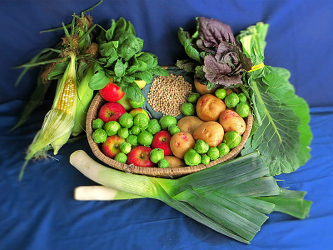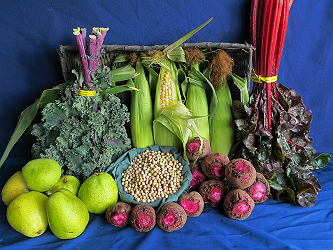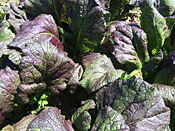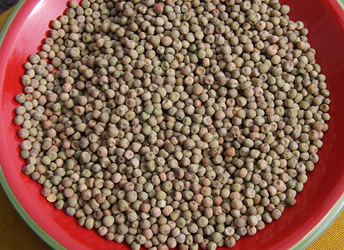
Standard
Apples/Pears 3 lbs
Spinach 1 bu
Corn 4 ears
Collards 1 bu
Leeks 2
Field Peas 2 lbs
Red Mustard 1 bu
#2 Potatoes 5 lbs
Brussels Sprouts 1.5 lbs

Small
Apples/Pears 3 lbs
Red Kale 1 bu
Corn 4 ears
Red Chard 1 bu
Red Beets 3 lbs
Field Peas 2 lbs
Red Mustard Greens

Red mustard greens are rich in vitamins A, C and K. They contain compounds which have cancer preventing benefits, including antioxidants, anti-inflammatory and natural detoxifying properties.
Red mustard greens are interchangeable with most other varieties in the family, however their brilliant purple-red color gives them extra visual
appeal.
They can be used both cooked and raw and are commonly implemented as a salad or braising green. They pair well with rich meats (such as pork, lamb and sausages), creamy sauces, aged and melting cheeses, apples, peaches, cucumbers, citrus, vinegars (especially apple cider and rice), nuts (like pistachios and hazelnuts), and herbs and spices (including cumin, cilantro, dill, garlic, fennel and coriander).
Simple Sauté
Smash 3 garlic cloves and let sit for a few minutes. Coat a large skillet with olive and place on medium-high heat. Add the garlic and a little crushed red pepper. Cook the garlic until it’s golden and aromatic. Remove and discard.
Remove the stems from one large bunch mustard greens and cut the leaves into 2-inch pieces. Rinse and leave wet. Toss into the flavored oil, season with salt, cover and cook until greens are soft. Stir in 2-3 tablespoons red wine vinegar, taste for seasoning and add more salt, if needed.
Field Peas

Dried field peas belong to the same family as beans and lentils and, like them, are a small but nutritionally mighty member of the legume family, and a very good source of cholesterol-lowering soluble fiber.
Soluble fiber helps to prevent constipation and digestive disorders like irritable bowel syndrome and diverticulitis. It also helps lower cholesterol and is of special benefit in managing blood-sugar disorders, since the high-fiber content stabilizes blood sugar levels and prevents them from rising rapidly after a meal. If you have insulin resistance, hypoglycemia or diabetes, legumes like dried peas can really help you balance blood sugar levels while providing slow-burning energy.
Field Peas & Collards (or Red Kale)
1 cup dried field peas
1 Tbsp. butter
1 large onion, finely chopped
3 cloves garlic, finely chopped
3 strips bacon, cut into small pieces
1 bay leaf
1 large bunch collard greens or red kale
1 tsp. of salt, plus more to taste
Pepper to taste
Put the peas and 4 cups of water in a bowl and soak overnight.
Melt the butter in a large saucepan over medium heat. Add the onion, garlic, bacon, and bay leaf. Cover the pan and leave it for 2 minutes. Stir occasionally and cook until onion is translucent and bacon is starting to crisp, about 5 minutes.
Drain the peas and pour them into the saucepan. Cover them with water and turn the heat down to medium-low. Cook for 45 minutes, or until the peas are easily crushed with a fork. Be sure to check occasionally that the water does not cook off. While the peas cook, remove the stems from the collard/kale greens and chop the leaves into bite size pieces. Once the peas are cooked, add the greens, salt to taste and some freshly ground pepper, and stir. Cover the pan and leave until the greens are tender, about 10 minutes. Remove from the heat and serve.
Adapted from the cookbook Good and Cheap by Leanne Brown.
